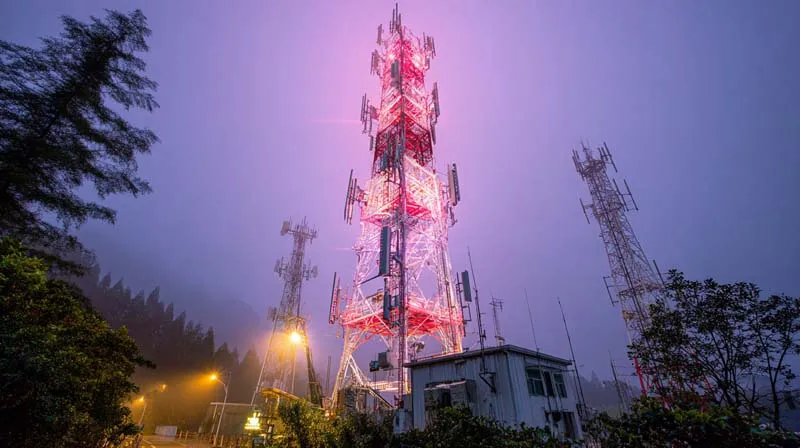The surge of 5G, cloud computing, and AI data centers demands robust network solutions. CWDM and DWDM, key pillars of wavelength division multiplexing (WDM), deliver high-efficiency connectivity through complementary strengths.
CWDM and DWDM: Distinct Yet Complementary
CWDM and DWDM boost network capacity by transmitting multiple wavelengths over a single fiber. Their unique traits shape their roles in modern networks.
CWDM (Coarse Wavelength Division Multiplexing):
CWDM uses wavelengths from 1270nm to 1610nm, with 20nm spacing, supporting 8-18 channels. It employs uncooled lasers, consuming just 0.5W. Compared to CWDM and DWDM, CWDM’s cost is 4-5 times lower. It suits short-range transmission (80-160km), ideal for metro access networks, 5G fronthaul, and enterprise networks. Its affordability and flexibility make it perfect for smaller-scale deployments.
DWDM (Dense Wavelength Division Multiplexing):
DWDM operates in the C-band (1530nm-1565nm) and L-band (1570nm-1610nm), with tight 0.4nm-1.6nm spacing. It supports 40-160 channels, delivering tens of Tbps per fiber. DWDM relies on high-precision lasers and erbium-doped fiber amplifiers (EDFAs). It excels in long-haul backbone networks, data center interconnects (DCI), and submarine cables. Its high capacity is unmatched, despite higher costs.
Additionally, LWDM (LAN WDM), a newer technology, uses the O-band (1269nm-1332nm) with 4nm spacing. It balances low dispersion and high capacity, fitting 100G/400G data center modules. Together, CWDM and DWDM, alongside LWDM, form a versatile network ecosystem.
Market Demand: Fueled by 5G, Cloud, and AI
The digital era drives explosive demand for bandwidth and low latency. CWDM and DWDM address these needs effectively.
5G Networks:
5G fronthaul requires cost-effective, high-bandwidth solutions. CWDM shines with its simple design and fast deployment. DWDM supports metro core and long-haul backhaul, handling dense traffic. For example, China Mobile uses CWDM modules to cut 5G fronthaul costs, while DWDM boosts backbone capacity.
Cloud and Data Centers:
Hyperscale data centers demand high-throughput interconnects. Consequently, 800G optical modules are gaining traction. CWDM and DWDM play distinct roles: CWDM4 modules (1271nm-1331nm) handle 100G/400G short-range links, while DWDM supports long-distance DCI. Reports predict 800G modules will peak in 2025-2026, with DWDM leading the DCI market.
AI Growth:
AI training and inference need ultra-low latency and high throughput. CWDM and DWDM offer flexible bandwidth solutions. CWDM connects AI clusters locally, while DWDM links data centers globally.
Industry data projects the optical communication market to exceed $30 billion by 2025. CWDM and DWDM account for over 60% of this market. Notably, DWDM module prices have dropped 20-25%, expanding their cost-effective use.
Synergistic Ecosystem: CWDM and DWDM in Harmony
CWDM and DWDM complement each other, creating an efficient network ecosystem with LWDM.
Layered Applications:
CWDM: Excels in access layers, supporting 5G base stations, enterprise, and campus networks. For instance, Beijing Senrunda’s SRD-series CWDM modules power gigabit Ethernet and storage area networks (SAN).
DWDM: Dominates backbone and DCI, offering high capacity and long-range transmission. PacketLight Networks’ latest ROADM enables dynamic wavelength allocation for AI data centers.
LWDM: Bridges the gap for short-range data center interconnects, ideal for 100G/400G modules.
Hybrid Deployments:
Hybrid CWDM and DWDM systems balance cost and performance. For example, Time Warner partnered with LuxN to deploy DWDM with CWDM modules for gigabit Ethernet in New York. Similarly, Ocular’s OSX switches use CWDM for dedicated SAN wavelength channels, boosting efficiency.
Technical Synergy:
Advanced multiplexers and modules enhance CWDM and DWDM integration. ETU-LINK’s 16G CWDM/DWDM SFP+ modules support 40km transmission, meeting SFP+ MSA standards. AWG and TFF technologies reduce insertion loss, improving system performance.
This layered and hybrid approach cuts costs and maximizes bandwidth, enabling seamless network scalability.
Technical Innovations: Advancing CWDM and DWDM
Innovations in CWDM and DWDM are transforming the industry.
High-Capacity Modules:
800G QSFP-DD 2xFR4 modules leverage CWDM4 technology, using 1310nm DFB lasers for 2km transmission. DWDM SFP+ modules achieve 14.025Gbps over 40km, serving C-band long-haul needs.
Advanced Multiplexers:
DWDM multiplexers with AWG technology optimize passband flatness and reduce insertion loss, supporting 40+ channels. CWDM multiplexers, like LuxN’s widewav, shrink package sizes for metro applications.
Photonic Integrated Circuits (PICs):
PICs integrate lasers, modulators, and detectors into a single chip, slashing DWDM costs. At OFC 2025, PICs showed potential for 25GHz spacing and 200+ channels.
Standardization Efforts:
ITU-T G.694.2 and G.695 standardize CWDM wavelength grids. Contributions from Nokia Bell Labs advance industry norms. Progress in E-band (1270nm-1470nm) optics will unlock CWDM’s full potential.
Future Outlook: Evolving Together
The future of CWDM and DWDM is bright, driven by innovation and demand.
CWDM: Enhanced E-band optics will support more channels (18+), cutting costs for 5G and enterprise networks.
DWDM: Expansion to the U-band (1625nm-1675nm) and integration with ROADM/SDN will enable smarter networks.
Synergistic Ecosystem: CWDM and DWDM, with LWDM, will form a seamless architecture for access, backbone, and DCI.
The optical communication market will grow over 10% annually through 2030. CWDM and DWDM will lead this trend. Businesses should invest in these technologies to stay competitive.
Conclusion: Building the Future with CWDM and DWDM
CWDM and DWDM drive next-generation connectivity through synergy. From cost-effective access layers to high-capacity backbones, they balance cost, performance, and scalability. Fueled by 5G, cloud, and AI, CWDM and DWDM are shaping the future of optical networks. Explore our solutions today and build a connected tomorrow!





